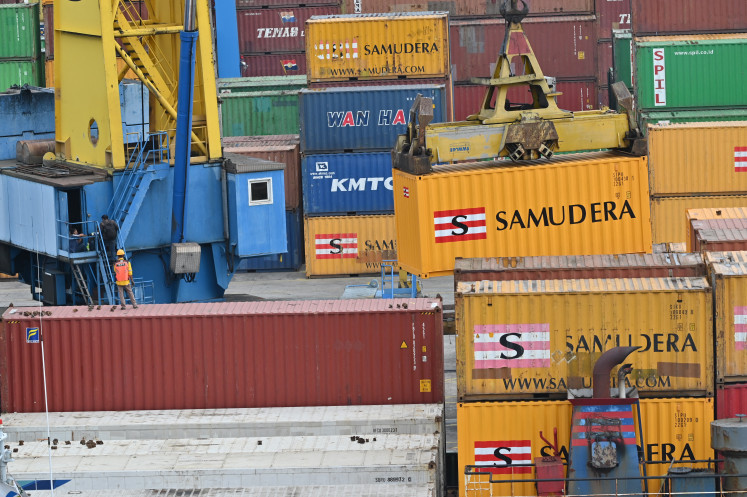Jatnika Nanggamiharja: A passion for bamboo
Jatnika Nanggamiharja: JP/Theresia Sufa“If the Sundanese wish to live prosperously, be free from various diseases and disasters, and survive peacefully without outside domination, they should grow 1,000 clums of bamboo
Change text size
Gift Premium Articles
to Anyone

Jatnika Nanggamiharja: JP/Theresia Sufa
“If the Sundanese wish to live prosperously, be free from various diseases and disasters, and survive peacefully without outside domination, they should grow 1,000 clums of bamboo.”
The edict came from Prince Haur Koneng, one of the sons of Prabu Siliwangi, who reigned over the Sundanese Padjajaran kingdom.
The time-honored tradition initiated by Prince Haur Koneng motivated Jatnika to establish a bamboo handicraft business.
Jatnika Nanggamiharja, born in 1956, in Cikidang village, Sukabumi, West Java, and who now chairs the Indonesian Bamboo Foundation, is still very much involved in bamboo crafts.
“My father and uncle were bamboo craftsmen who produced various kinds of household furniture, kitchen utensils and plaiting works. I became interested in bamboo after watching them make bamboo articles, and started learning the skill when I was a third grader,” said the father of six.
After finishing his studies at the Indonesian Corporate Executive Academy in Jakarta in 1978, Jatnika worked as the order and sanitary chief for Jakarta’s Glodok shopping zone until 1981. In his spare time, he continued to produce bamboo chairs, which he sold in Jakarta and surrounding areas before returning to return to Bogor in 1985 and focusing on bamboo craft.
“In 1985, I started focusing on building bamboo houses like small gazebos, with a starting capital of only Rp 200,000, as well as set up bamboo handicraft studios in Bogor, Jakarta, Bekasi and Tangerang. Inspired by the model of Sundanese or West Java community homes, my gazebo products were in high demand, which gave me more confidence to pursue the business,” recalled Jatnika.
In 1995, after being fostered by the National Handicraft Council headed by the wife of then Vice president Tri Sutrisno, Jatnika joined exhibitions in different Asia-Pacific countries.
“I am grateful to have met ibu Tri Sutrisno, who made my overseas travels possible and founded the Indonesian Bamboo Foundation located in Sukahati sub-district, Cibinong district, Bogor regency,” Jatnika said.
In the past, bamboo houses were associated to poverty because only low-income families in the rural areas or remote regions of West Java lived in bamboo structures. Today, however, the rich are increasingly interested in bamboo houses.
Jatnika’s builds three types of modified bamboo houses: traditional houses with thatched roofs and bamboo floors, which cost Rp 1.2 million per meter, medium/standard-class houses with roof tiles and ceramic floors, at Rp 1.5 million per meter, and stylish houses with half stone walls, roof tiles, wooden frames and window panes costing Rp 1.7 million per meter. Bamboo gazebos and restaurants are cheaper.
Apart from meeting the demands of the domestic market, Jatnika also exports his bamboo houses to Malaysia, Singapore and Brunei, and soon to Dubai. His bamboo chairs are mostly exported to Spain and Taiwan.
He spends his business earnings partly on his children’s college tuition and school fees, and partly
on compensating the work of his trainees affiliated with Kidang Kencana, an association of craftspeople helping with his business development.
The dearth of skilled workers in the bamboo house sector has led him to fund training to ensure a reliable supply of crasftpeople.
“So far I’ve produced 3,041 bamboo houses and in mid-2010 I cooperated with Pustaka Rumah Kebun to publish my collection of bamboo houses entitled Rumah bambu arsitektur khas Jawa Barat [Bamboo houses, West Java’s typical architecture]. I’m sure a lot more people will like these houses.
Previously seen as a wild plant, bamboo is now used to make more than 1,500 pieces of household furniture. This was implemened in West Java as a 500-year-old cultural legacy. I’ve also created 41 Sundanese bamboo musical instruments,” said Jatnika.
Out of his love of bamboo, Jatnika — in cooperation with the biodiversity foundation KEHATI and ALSTOM Indonesia — planted five species of bamboo around the area of the Indonesian Bamboo Foundation and on the bank of Ciliwung River in Sukahati sub-district, Cibinong, Bogor, on Jan. 13, 2011. With the economic and ecological function of bamboo, Jatnika hopes Indonesia will have a bamboo tourist park in view of the country’s diverse species of bamboo.









